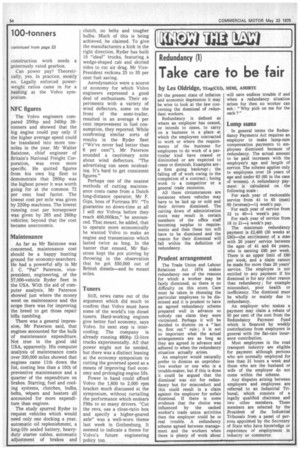Redundancy (1)
Page 58

If you've noticed an error in this article please click here to report it so we can fix it.
Take care to be fair
by Les Oldridge, TEng(CE1),
MIMI, AMIRTE IN the present state of inflation and economic depression it may be wise to look at the law concerning the dismissal of redundant workers.
Redundancy is defined as where an employer has ceased, or intends to cease, to carry on a business in a place at which the employees contracted to work or where the requirements of the business for employees to do work of a particular kind have ceased or diminished or are expected to cease or diminish. Examples are : a firm going bankrupt ; the falling off of work owing to the completion of a contract ; losing work to a competitor or a general trade recession.
All these circumstances are instances where vehicles may have to be laid up or sold and their drivers dismissed. The cutting down of administration costs may result in certain members of the office staff becoming surplus to requiremenLs and then these too will have to be dismissed and the reason for their dismissal will fall within the definition of redundancy.
Prudent arrangement
The Trade Union and Labour Relations Act 1974 makes redundancy one of the reasons for which a worker may be fairly dismissed, so there is no difficulty on this score. Care must be taken in choosing the particular employees to be dismissed and it is prudent to have an agreed redundancy scheme prepared well in advance so nobody can claim they were victimised. Perhaps it will be decided to dismiss on a "last in, first out" rule ; it is not so important what the actual arrangements are as long as they are agreed in advance and adhered to when the redundancy situation actually arises.
An employer would naturally prefer to dismiss an unproductive worker or one who is a trouble-maker, but if this is done it could be argued that the dismissal was not for redundancy but for misconduct and this could result in a claim against the employer for unfair dismissal. If there is some evidence that the choice was influenced by the sacked worker's trade union activities then the employer could be in real trouble. A redundancy scheme agreed between management and the workers •when there is plenty of work about will save endless trouble if and when a redundancy situation arises for then no worker can ask : "Why pick on me for the sack ?"
Lump sums
In general terms the Redundancy Payments Act requires an employer to make lump-sum compensation payments to employees dismissed because of redundancy. The actual amount to be paid increases with the employee's age and length of service. The scheme applies only to employees over 18 years of age and under 65 (60 in the case of women). A redundancy payment is calculated on the following scale : For each year of reckonable service from 41 to 65 (man) 60 (woman)—li week's pay.
For each year of service from 22 to 40-1 week's pay.
For each year of service from 18 to 21—i week's pay.
The maximum redundancy payment is £2,400 (30 weeks at £80)—the entitlement of a man with 20 years' service between the ages of 41 and 64 years, who is earning £80 per week. There is an upper limit of £80 per week, and a claim cannot be made for more than 20 years' service. The employee is not entitled to any payment if his dismissal is for any other reason than redundancy ; for example misconduct, poor health or inefficiency. The dismissal must be wholly or mainly due to redundancy.
An employer who makes a payment may claim a rebate of 50 per cent of the cost from the Redundancy Payment Fund which is financed by weekly contributions from employers in general with the flat-rate insurance contribution.
Most employees in the road transport industry are eligible for payment although persons who are normally employed for less than 21 hours a week and those who are the husband or wife of the employer do not come within the scheme.
Any disputes arising between employers and employees are referred to an Industrial Tribunal, which consists of a legally qualified chairman and two other members. These members are selected by the President of the Industrial Tribunals from a panel of persons appointed by the Secretary of State who have knowledge or experience of employment in industry or commerce.






























































































